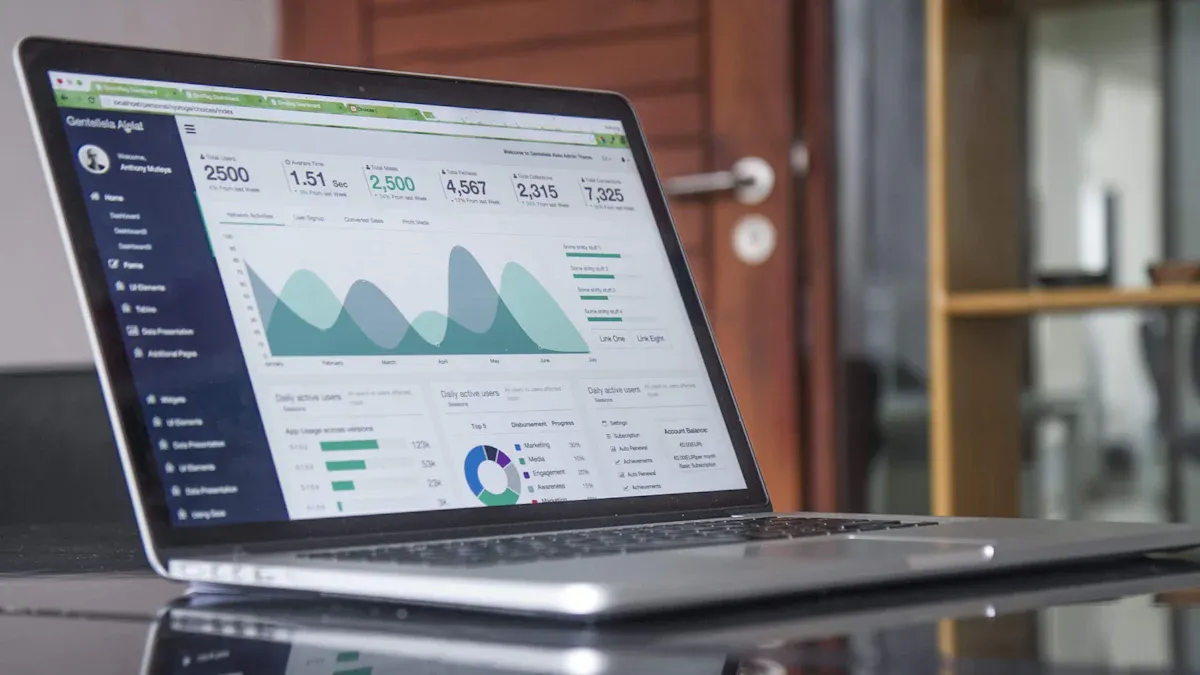What Is an EOS & How Does It Speed B2B Orders?

EOS, or the Entrepreneurial Operating System, is a practical framework that helps you simplify and optimize your business operations. It focuses on organizing your workflows, ensuring clear communication among teams, and holding everyone accountable for their roles. By using EOS, you can overcome bottlenecks, reduce confusion, and create a streamlined process. This efficiency allows you to handle B2B orders faster, ensuring timely delivery and satisfied customers.
Key Takeaways
EOS makes business easier by focusing on six parts: Vision, People, Data, Issues, Process, and Traction. Using these parts helps work get done faster.
Good communication is key to faster B2B orders. EOS creates clear rules that cut mistakes and make work smoother, speeding up orders.
Knowing roles and being responsible improves work speed. Tools like the Accountability Chart show who does what, helping teams finish on time.
EOS automates boring tasks to avoid mistakes and save time. This lets workers do more important jobs and boosts productivity.
Fixing problems often with the IDS method builds a problem-solving habit. This stops issues from coming back and helps make quick decisions.
What Is EOS?

Definition of EOS
EOS, or the Entrepreneurial Operating System, is a comprehensive framework designed to help businesses operate more effectively. It provides a structured approach to managing and growing your company by focusing on six key components: Vision, People, Data, Issues, Process, and Traction. Unlike traditional management systems, EOS simplifies operations by using practical tools and straightforward concepts. This system ensures that your team stays aligned, accountable, and focused on achieving shared goals.
Did you know? Over 80,000 companies worldwide have adopted EOS, reporting significant improvements in employee engagement and operational efficiency. Many of these businesses have experienced an average revenue growth rate of 18% over three years.
Core Components of EOS
The six core components of EOS work together to create a strong foundation for your business. Each component addresses a critical area of operations, ensuring that your company runs smoothly and efficiently:
Component | Description |
|---|---|
Vision | Clearly defining where your company is going and how it will get there. |
People | Getting the right people in the right seats. |
Data | Using a handful of numbers to provide absolute clarity on performance. |
Issues | Identifying and solving problems quickly and permanently. |
Process | Systematizing core processes to create consistency and scalability. |
Traction | Instilling discipline and accountability throughout the organization. |
These components are not just theoretical ideas. They are actionable steps that you can implement to improve your business. For example, focusing on "People" ensures that every team member is in a role that matches their strengths. Meanwhile, "Traction" helps you maintain accountability through regular check-ins and measurable goals.
Real-world impact: A healthcare provider used EOS to reassign team roles based on employees' strengths, leading to improved patient care and higher staff satisfaction. Similarly, a retail chain leveraged the "Data" component to identify underperforming products, boosting sales through targeted marketing strategies.
Purpose of EOS in Business Operations
The primary purpose of EOS is to help you build a business that operates efficiently and achieves its goals. By addressing the six core components, EOS creates a unified system that fosters alignment, accountability, and productivity. Here’s how it benefits your operations:
Improved communication: EOS ensures that everyone in your organization understands the company’s goals and their role in achieving them. This clarity fosters teamwork and better decision-making.
Enhanced accountability: By defining ownership of tasks and success metrics, EOS encourages a culture of responsibility. Team members stay motivated and focused on delivering results.
Systematic problem-solving: The IDS (Identify, Discuss, Solve) process equips you with tools to address challenges effectively. This approach eliminates recurring issues and drives long-term improvements.
Proven results: Companies that implement EOS often see measurable improvements. For instance, an IT firm reduced system downtime by half by using regular issue-tracking meetings. Another business improved its Organizational Checkup score from 40% to 85.25% within 18 months, showcasing the system's effectiveness.
EOS is not just a framework; it’s a transformative tool that empowers you to take control of your business. By simplifying operations and focusing on what truly matters, EOS helps you achieve sustainable growth and long-term success.
How EOS Speeds Up B2B Orders
Streamlined Communication Between Teams
Clear communication is essential for speeding up B2B orders. EOS helps you establish standardized practices across teams, ensuring everyone follows the same procedures. This consistency reduces discrepancies and errors, making processes more efficient. For example, when workflows are streamlined, tasks require less time and effort, allowing your team to focus on delivering results faster.
Tracking timing metrics is another way EOS improves communication. By identifying delays and inefficiencies, you gain valuable insights to refine operations. Establishing benchmarks from previous projects also sets realistic timelines, helping your team plan better and meet deadlines.
Practice | Impact on Processing Times |
|---|---|
Standardized practices | Simplifies coordination and communication, reducing discrepancies and errors. |
Streamlined workflows | Reduces time and effort needed for tasks, allowing quicker completion. |
Tracking timing metrics | Provides insights for process improvements, enabling faster operations. |
Establishing benchmarks | Sets realistic timelines and expectations, improving planning and efficiency. |
EOS empowers you to create a communication system that eliminates confusion and accelerates order processing.
Improved Accountability and Role Clarity
Accountability and role clarity are critical for efficient operations. EOS provides tools like the Accountability Chart and Role Definition to ensure every team member knows their responsibilities. When roles are clearly defined, your team can focus on their tasks without overlapping efforts or confusion.
Regular pulse meetings reinforce accountability by encouraging ongoing communication. These meetings help your team stay aligned and address issues promptly. Scorecards track critical metrics, giving you objective measurements of progress and performance. The Integrator Role unifies teams under a shared vision, fostering synergy and strategic advancements.
EOS Technique | Governance Impact | Outcome for Teams |
|---|---|---|
Role Definition | Clarifies team member duties | High-performing teams aligned with goals. |
Accountability Chart | Defines who is accountable | Transparency in task ownership. |
Regular Pulse Meetings | Encourages ongoing communication | Swift issue resolution. |
Scorecards | Tracks critical metrics | Objective measurement of progress. |
Integrator Role | Unifies teams under shared vision | Organizational synergy. |
By using EOS, you create a culture of accountability that drives efficiency and ensures faster order fulfillment.
Simplified and Automated Processes
Complex processes slow down B2B orders. EOS simplifies operations by systematizing core workflows. When you document and standardize processes, your team can execute tasks consistently and efficiently. This reduces errors and ensures scalability as your business grows.
Automation is another key benefit of EOS. By integrating tools that automate repetitive tasks, you free up your team to focus on higher-value activities. For instance, automating order tracking and inventory management speeds up fulfillment and reduces manual errors.
EOS also emphasizes continuous improvement. By regularly reviewing and refining processes, you eliminate bottlenecks and improve overall efficiency. This approach ensures your business stays agile and responsive to customer needs.
With EOS, you gain a streamlined and automated system that accelerates B2B order processing while maintaining quality.
Faster Decision-Making and Problem-Solving
Making decisions quickly and solving problems effectively are critical for keeping your business operations smooth. EOS equips you with tools and strategies to address challenges head-on and make informed decisions without delay. By focusing on structured processes and data-driven insights, you can eliminate guesswork and tackle issues with confidence.
One of the most powerful tools in EOS is the IDS (Identify, Discuss, Solve) method. This approach helps you prioritize the top three issues affecting your business each week. During weekly Level 10 Meetings, your team identifies these challenges, discusses potential solutions, and implements the best course of action. This structured process ensures that problems are resolved promptly and don’t linger, disrupting your operations.
Tip: Regularly addressing issues in a systematic way prevents them from snowballing into larger problems. It also fosters a culture of proactive problem-solving within your team.
EOS also emphasizes the importance of tracking key metrics to guide decision-making. By monitoring performance data, you gain a clear understanding of what’s working and what needs improvement. This clarity allows you to make decisions based on facts rather than assumptions. For example, if your data shows a delay in order fulfillment, you can immediately investigate and resolve the bottleneck.
Here’s how EOS accelerates decision-making and problem-solving in your business:
Weekly and quarterly meetings keep your team focused and accountable.
The IDS method ensures that the most pressing issues are addressed first.
Data-driven decision-making highlights areas for improvement and success.
By integrating these practices into your operations, you create a system that not only resolves issues faster but also prevents them from recurring. This efficiency translates directly into faster B2B order processing and improved customer satisfaction.
Key Benefits for B2B Companies
Faster Order Processing
Speed is critical in B2B transactions. When your business processes orders quickly, you gain a competitive edge. EOS helps you achieve this by streamlining workflows and eliminating unnecessary steps. With clearly defined roles and responsibilities, your team can focus on completing tasks without delays.
For example, automated systems integrated through EOS reduce the time spent on manual data entry. This allows your team to process orders faster and with greater accuracy. Additionally, regular team meetings ensure that everyone stays aligned, minimizing miscommunication that could slow down operations.
Tip: Faster order processing not only improves efficiency but also strengthens your reputation as a reliable partner in the B2B space.
Reduced Errors in Transactions
Errors in transactions can damage relationships with your clients. EOS minimizes these mistakes by standardizing processes and introducing accountability at every level. When your team follows a consistent approach, the chances of errors decrease significantly.
Scorecards, a key tool in EOS, allow you to track performance metrics and identify areas where mistakes occur. By addressing these issues proactively, you can prevent them from recurring. Automation also plays a role here, as it reduces the likelihood of human error in repetitive tasks like invoicing or inventory updates.
Did you know? Businesses that adopt EOS often report a 30% reduction in transaction errors within the first year of implementation.
Enhanced Customer Satisfaction
Satisfied customers are the backbone of any successful B2B company. EOS helps you deliver exceptional service by ensuring that orders are processed accurately and on time. When your clients receive their products without delays or errors, their trust in your business grows.
EOS also fosters a culture of continuous improvement. By regularly reviewing your processes, you can adapt to changing customer needs and expectations. This proactive approach ensures that your business remains customer-focused and competitive in the long run.
Proven benefit: A logistics company using EOS improved its Net Promoter Score (NPS) by 25% after implementing streamlined processes and enhancing communication with clients.
Scalability and Growth Opportunities
Scalability is essential for any business aiming to grow and adapt to changing demands. EOS equips you with the tools to build scalable systems that handle increased order volumes without sacrificing efficiency. By standardizing processes and automating repetitive tasks, you create a foundation that supports growth while maintaining operational consistency.
A scalable system ensures your business can meet customer expectations, even during peak seasons or unexpected surges in demand. For example, when your order volume doubles, a well-designed fulfillment process allows you to manage the increase seamlessly. This adaptability not only improves customer satisfaction but also strengthens your reputation as a reliable partner.
EOS also helps you allocate resources more effectively. With clear data and streamlined workflows, you can optimize labor, warehouse space, and other assets. This prevents underutilization or overextension, ensuring your operations remain cost-effective as you scale. Additionally, scalability enables you to onboard new products quickly, accelerating time-to-market and giving you a competitive edge.
Pro Tip: Use EOS tools like the Process Component to document and refine workflows. This ensures your team can replicate success as your business grows.
Here’s a closer look at how scalability benefits your B2B operations:
Evidence Supporting Scalability and Growth Opportunities in B2B Order Processing |
|---|
Well-designed fulfillment systems can adapt to increased order volumes, ensuring a seamless experience for both the business and its customers. |
Scalability allows businesses to handle fluctuations in order volumes efficiently, meeting customer expectations without compromising on efficiency. |
A scalable fulfillment system enables efficient allocation of resources, including labor and warehouse space, preventing underutilization or overextension. |
Scalability allows for quick onboarding of new products into existing logistics infrastructure, accelerating time-to-market. |
Businesses can benefit from scalable operations when expanding geographically, accommodating increased complexity and volume. |
Scalability ensures efficient handling of increased demand during seasonal peaks, maintaining service quality. |
By implementing EOS, you position your business for sustainable growth. Whether you’re expanding into new markets or managing seasonal spikes, scalability ensures you stay ahead of the curve.
Real-World Examples of EOS in Action

Case Study: A Manufacturing Firm Achieves Faster Order Fulfillment
A medium-sized manufacturing firm implemented EOS to address inefficiencies in its operations. The leadership team set quarterly goals, or "Rocks," to reduce machine downtime by 20% and introduce a new inventory management system. These Rocks provided clear direction and measurable objectives for the team.
By focusing on these priorities, the company reduced operational downtime, which increased production output by 15%. The new inventory system improved accuracy, cutting waste and lowering costs. These changes streamlined the order fulfillment process, enabling the firm to process and ship orders faster.
Key takeaway: Setting specific goals and aligning your team around them can lead to measurable improvements in efficiency and customer satisfaction.
Case Study: A Tech Company Improves Team Communication
A tech company struggled with miscommunication between its development and sales teams, leading to delays in project delivery. After adopting EOS, the company implemented weekly Level 10 Meetings to improve collaboration. These meetings provided a structured platform for teams to share updates, discuss challenges, and align on priorities.
The Accountability Chart clarified roles, ensuring each team member understood their responsibilities. This clarity reduced overlap and improved productivity. Over time, the company saw a significant reduction in project delays and an increase in client satisfaction.
Pro Tip: Regular team meetings and clear role definitions can eliminate confusion and foster better communication across departments.
Case Study: A Retail Business Reduces Operational Errors
A retail business faced frequent errors in inventory tracking and order processing. By adopting EOS, the company standardized its core processes and introduced automation tools for repetitive tasks like inventory updates. These changes reduced human error and improved operational consistency.
The business also used scorecards to track key performance metrics, identifying problem areas and addressing them proactively. As a result, transaction errors dropped by 30%, and customer complaints decreased significantly.
Did you know? Automating repetitive tasks not only reduces errors but also frees up your team to focus on higher-value activities.
How to Implement EOS
Overview of the EOS Model®
The EOS Model® provides a structured framework to help you manage and grow your business effectively. It focuses on six key components: Vision, People, Data, Issues, Process, and Traction. Each component addresses a critical area of your operations, ensuring that your business runs smoothly and achieves its goals.
This model simplifies complex business challenges by breaking them into manageable parts. For example, the Vision component helps you define your long-term goals and align your team around them. The Process component ensures consistency by documenting workflows, while Traction instills discipline through measurable objectives. Together, these components create a unified system that drives efficiency and accountability.
Tools for Implementation: EOS Toolbox™ and EOS Process®
The EOS Toolbox™ and EOS Process® offer practical tools to implement the EOS framework in your business. These tools focus on creating consistency, improving team health, and enhancing accountability.
The EOS Toolbox™ includes resources like the Vision/Traction Organizer (V/TO), Accountability Chart, and Scorecards. These tools help you clarify your goals, define roles, and track progress effectively.
The EOS Process® emphasizes the importance of documenting core workflows. This ensures that your team delivers a consistent experience to clients and scales operations seamlessly.
Weekly Level 10 meetings, a key part of the EOS Process®, foster collaboration and accountability. These meetings help your team address issues promptly and stay focused on priorities.
By using these tools, you can transform your business into a unified enterprise with a common vision and measurable success.
Steps to Adopt EOS in Your Business
Adopting EOS involves a step-by-step approach that ensures measurable benchmarks and timelines. Here’s how you can implement it:
Clarify Your Vision: Use the Vision/Traction Organizer (V/TO) to define your long-term goals, core values, and mission.
Build the Right Leadership Team: Ensure the right people are in the right roles, accountable for specific functions.
Define Roles and Responsibilities: Create an Accountability Chart to clarify roles and responsibilities within your organization.
Establish a Meeting Rhythm: Implement regular meetings, such as weekly Level 10 meetings, to maintain focus and accountability.
These steps help you align your team, streamline operations, and achieve sustainable growth. By following this process, you can create a business that operates efficiently and adapts to changing demands.
EOS offers a practical framework to simplify your business operations. It enhances communication, accountability, and efficiency, making it easier to process B2B orders quickly. By adopting EOS, you can reduce errors, improve customer satisfaction, and position your business for sustainable growth. Its tools and strategies empower you to streamline workflows and tackle challenges effectively. Explore EOS to transform your operations and achieve measurable success.
FAQ
What types of businesses benefit most from EOS?
EOS works well for small to medium-sized businesses across industries. Companies with teams of 10–250 employees often see the most impact. If your business struggles with communication, accountability, or scaling operations, EOS can help you streamline processes and achieve growth.
How long does it take to implement EOS?
Most businesses fully implement EOS within 12–24 months. The timeline depends on your team’s commitment and the complexity of your operations. You can start seeing improvements in communication and efficiency within the first few months of adoption.
Do I need a professional EOS Implementer®?
Hiring a professional EOS Implementer® can accelerate the process and ensure proper execution. However, you can self-implement EOS using resources like the EOS Toolbox™ and books such as Traction by Gino Wickman. Choose the option that fits your budget and goals.
Can EOS integrate with existing tools and software?
Yes, EOS complements most tools and software. For example, you can use EOS Scorecards alongside project management platforms like Asana or Trello. The framework focuses on processes and accountability, so it adapts to your current systems without requiring major changes.
Is EOS suitable for remote or hybrid teams?
EOS works effectively for remote and hybrid teams. Tools like virtual Level 10 Meetings and cloud-based Scorecards keep everyone aligned. Clear processes and accountability ensure your team stays productive, no matter where they work.
Tip: Use video conferencing tools for meetings to maintain engagement and foster collaboration in remote setups.
See Also
Reasons Static Delivery Strategies Struggle In Same-Day Retail
Understanding Route Optimization Algorithms For Speedy Deliveries
Effective Strategies For Weekly Demand Forecasting In Retail
Fundamentals Of Cross-Border Compliance: VAT, Customs, And Residency
Exploring The Key Differences Between Omnichannel And Multichannel
